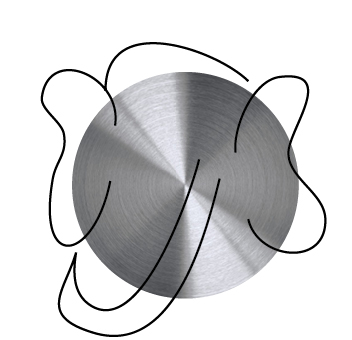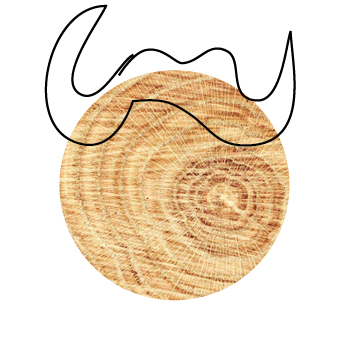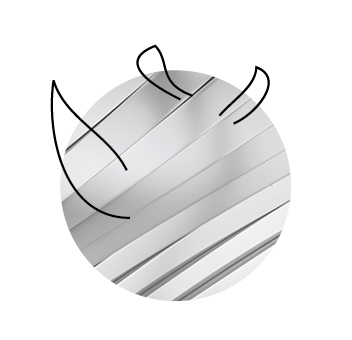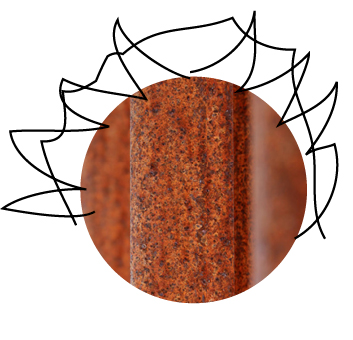OUR MATERIALS
GUIDEBOOK
Quality-tested raw materials
The wishes and requirements regarding open space designs are becoming more and more demanding. Many planners, as well as municipalities and builders, want solutions for open space furniture that combine comfort and aesthetics with functionality.
That is why we have specialized in custom made constructions in the field of street furniture. We are your specialist consultant in the construction of furniture in material combinations of steel, wood, aluminium and corten steel.

1
Steel for the open space
The perfect material for outdoor use
Galvanizing
Hot-dip galvanizing in accordance with EN ISO1461 ensures optimum corrosion protection, with the average zinc film applied being 55 microns. The surface structure after hot-dip galvanizing is not always smooth, but often slightly wavy. This is a typical characteristic of hot-dip galvanizing and does not represent a defect. Galvanized surfaces become grayish matt after a short time and do not change afterwards anymore.
Powder coating
Galvanized metal parts can also be supplied with a powder coating, whereby the layer thickness of the powder is at least 80 microns. (500 h salt spray test according to DIN 50021-SS or ISO 9227 UV – resistance of the powder according to the Qualicoat warranty table). Powder-coated metal parts can be supplied in almost all RAL colours (except pearl and fluorescent colours), but also in the special colour "Corten effect". If the color coating of a product is damaged, immediate treatment with a suitable paint is recommended to avoid consequential damage.

2
Wood for the open space
Wood develops personality
Wood is one of the oldest building materials of all – and a classic. Not only for indoor use, but also for outdoor use. Depending on the type of tree, the wood has very different hardnesses and properties - and some woods are also naturally weatherproof.
Different types of wood have a different degree of weather resistance, depending on the area of application, hardness also plays a certain role.
NOTE: We refer to the specific characteristics of each type of wood. Wood is a material that works, is subject to weather influences and is partly vulnerable against insect or fungal infestation, etc. Please understand that we cannot assume any liability for wood-specific reactions such as cracks, split ends, resin leakage, wood-standard curvature, the detachment of annual ring tips, flaking and flaking of glaze surfaces, gray-black discoloration, leakage of tannic acid (e.g. oak), etc. Further claims, in particular compensation for damages of any kind, are excluded.
Sources:
https://www.lwf.bayern.de/forsttechnik-holz/holzverwendung/052977/index.php
https://www.holzvomfach.de/fachwissen-holz/holz-abc/
http://www.holzwurm-page.de/holzarten/abiszk.htm
http://www.holzfragen.de/seiten/dauerhaftigkeitsklassen.html
Examples for wood types used for street furniture
– comes from Central Africa, very straight and cylindrical in size
– almost knot-free
– Heartwood is lemon yellow and darkens (grays in the open space)
– has little tendency for cracking and distortion
– even "quieter" than Iroko/Kambala
– weatherproof and termite-proof, therefore ideally suited for outdoor use
– very good elasticity, compressive and flexural strength
– has been used by us for about 20 years with very good experience, hence the corresponding warranty services
– relatively unknown and therefore also interesting in terms of price
– relatively unknown and therefore also interesting in terms of price
– Resistance class 3 according to EN 350-2
– we recommend using it without surface treatment;
on the one hand for environmental reasons and on the other hand to avoid maintenance and repair work
– slight leaching possible in the early stages
– Fresh weight: 980 kg/m³
– Weight dry: 680 kg/m³
– Compressive strength u12-15: 62 N/mm²
– Flexural strength u12-15: 110 N/mm²
– comes from West and Central Africa, very straight and cylindrical
– almost knot-free
– Heartwood from yellowish to greenish and darkens golden-olive brown to dark brown (grays in the open space)
– has little tendency for cracking and distortion
– weatherproof and termite-proof, therefore ideally suited for outdoor use
– very good elasticity, compressive and flexural strength
– limited availability and therefore correspondingly high prices
– Resistance class 1-2 according to EN 350-2
– we recommend using it without surface treatment;
on the one hand for environmental reasons and on the other hand to avoid maintenance and repair work
– slight leaching possible in the early stages
– Fresh weight: 1000-1100 kg/m³
– dry weight: 650-750 kg/m³
– Compressive strength u12-15: 50-70 N/mm²
– Flexural strength u12-15: 95 N/mm²
– also available as 100% FSC
- comes from France or the Slavic countries
– we mostly use the olive kernel ash, is more resistant and durable
– hard and very elastic wood
– Heartwood from light yellow to grey-brown
– Availability sufficient, waste not insignificant
– not weatherproof and termite-resistant without surface treatment, which must also be renewed regularly
– we do not offer thermal treatment, as this severely affects the elasticity
– Resistance class 4-5 according to EN 350-2
– Fresh weight: 600-800 kg/m³
– weight dry: 450-600 kg/m³
– Compressive strength u12-15: 45 N/mm²
– Flexural strength u12-15: 102 N/mm²
– also available as 100% FSC
– occurs in almost all of Europe
– very hard wood with high wear resistance
– Heartwood from light brown to reddish brown
– Availability sufficient, waste not insignificant
– weatherproof and termite-proof, therefore ideally suited for outdoor use
– Cracking must be accepted
– High tannic acid content should not be underestimated
– can only be installed in conjunction with stainless steel or powder-coated steel
– we recommend using it without surface treatment;
on the one hand for environmental reasons and on the other hand to avoid maintenance and repair work
– Resistance class 2 according to EN 350-2
– Fresh weight: 950-1100 kg/m³
– weight dry: 650-760 kg/m³
– Compressive strength u12-15: 42-64 N/mm²
– Flexural strength u12-15: 60-110 N/mm²
– also available as 100% FSC
– also occurs in Germany
– very similar to larch but slightly less resinous
– Heartwood from yellow-brown to reddish brown, quickly darkening
– Availability sufficient, I. quality – Earth trunk quality low in knots
– Gray-black discoloration reaction in contact with iron ions
– Softwood, but suitable for outdoor use if the graying is accepted
– we recommend using it without surface treatment;
on the one hand for environmental reasons and on the other hand to avoid maintenance and repair work
– in addition, resin removal would be additionally promoted
– Resistance class 3-4 according to EN 350-2
– Weight fresh: 640-800 kg/m³
– dry weight: 500-650 kg/m³
– Compressive strength u12-15: 42-68 N/mm²
– Flexural strength u12-15: 70-100 N/mm²
– also available as PEFC
– we use the slow-growing European mountain larch
– ist mal mehr, mal weniger ausharzend
– is more or less resinous which can not to be determined in advance
– Heartwood from yellowish to reddish to orange-brown, quickly darkening
– Availability sufficient, I. Quality very low in knots
– Gray-black discoloration reaction in contact with iron ions
– Harder softwood, but suitable for outdoor use if greying is accepted
– we recommend using it without surface treatment;
on the one hand for environmental reasons and on the other hand to avoid maintenance and repair work
– in addition, resin removal would be additionally promoted
– Resistance class 2-4 according to EN 350-2
– Fresh weight: 750-800 kg/m³
– Weight dry: 470-620 kg/m³
– Compressive strength u12-15: 45-62 N/mm²
– Flexural strength u12-15: 88-100 N/mm²
– Occurrence in the Mediterranean region
– easily confused with oak
– Heartwood from leather to dark brown, darkens
– Availability in corresponding quality rather low, therefore high price
– Frequent manifestation of ring peeling (onion effect) and often crooked and eccentric stem shapes
– Waste correspondingly large
– strongly prone to tearing and distortion
– Drying very delicate
– contains tannins
– medium-heavy hardwood but suitable for outdoor use if the greying is accepted
– we recommend using it without surface treatment;
on the one hand for environmental reasons and on the other hand to avoid maintenance and repair work
– Resistance class 2-4 according to EN 350-2
– Fresh weight: 750-800 kg/m³
– Weight dry: 470-620 kg/m³
– Compressive strength u12-15: 45-62 N/mm²
– Flexural strength u12-15: 88-100 N/mm²

3
Aluminum for the open space
A HIGH-TECH MATERIAL WITH A GREAT FUTURE
Contrary to widespread prejudices, aluminium products have a very good ecological balance and an excellent overall energy balance. The basic material is the third most abundant element in the earth's crust – i.e. it is substatially available. Aluminium products are light and stable at the same time, rot-proof, fully recyclable, pressable, kneadable, castable, easy to work with, sustainable and, above all, very affordable. Depending on the alloy, very different material properties can be achieved.
• The life cycle of aluminium is much longer than that of steel.
• Aluminum products do not rot and do not emit harmful substances, while steel products are more susceptible to rust and often need to be protected by paints that are difficult to separate.
• In the recycling process, aluminium is 100% recyclable as a recyclable material and requires significantly less effort for material separation than steel.

4
Corten steel for the open space
Patina that ripens with age
Characteristics and ripening cycle
In order to activate the maturation of the corten steel, Freiraumgestaltung Fischer does not use any chemical pre-treatment of the metal. Normally, our elements are delivered in rolled corten steel (color blue-black) and can only be slightly rusted.
Corten steel is considered a "living" material thanks to the maturation/oxidation process that characterizes it, which can vary in shades over time. Depending on the shape of the object, in the place where it is installed and depending on the weather conditions to which it is exposed.
Reduction of leaching
During the ripening phase of the corten, oxides can be washed out, which can leave residues on the surface where the Corten product is positioned. This is to be regarded as the natural and physiological behaviour of the material. In order to reduce oxide loss, the steel can be treated with a "RUST STOP AGENT", which the customer can request on top.
NOTES: The average time during which the natural ripening cycle of the corten "stabilizes" and the material acquires a "dark brown" hue typical of oxidized corten is about 12/18 months, depending on the weather conditions.
ATTENTION: It should be noted that in the vicinity of the sea, the salty air can lead to the formation of oxides, which can lead to even more different colors and appearance of the surface of the Corten steel than normal.
The placement of Corten products on porous surfaces (e.g. marble, granite, etc.) must be carefully considered. In these cases, euroform w proposes the use of galvanized and powder-coated steel in the special color "Corten effect".

WE ARE HERE FOR YOU!
Do you have a specific project or a construction project? Please feel free to write to us! Or give us a call. We look forward to working together for your special open space project!

